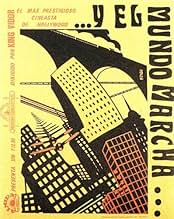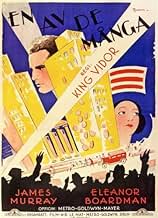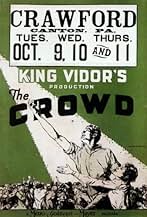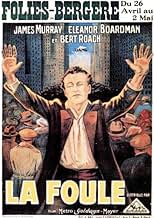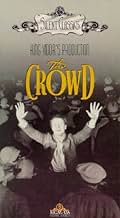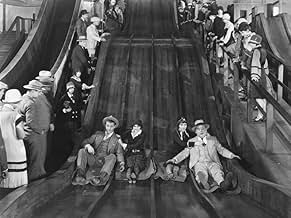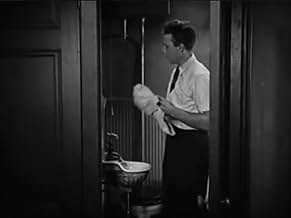VALUTAZIONE IMDb
8,0/10
9718
LA TUA VALUTAZIONE
Aggiungi una trama nella tua linguaThe life of a man and woman together in a large, impersonal metropolis through their hopes, struggles, and downfalls.The life of a man and woman together in a large, impersonal metropolis through their hopes, struggles, and downfalls.The life of a man and woman together in a large, impersonal metropolis through their hopes, struggles, and downfalls.
- Regia
- Sceneggiatura
- Star
- Candidato a 2 Oscar
- 4 vittorie e 2 candidature totali
John D. Bloss
- Boy on Fence
- (non citato nei titoli originali)
Roy Bloss
- Boy on Fence
- (non citato nei titoli originali)
Sidney Bracey
- John's Supervisor
- (non citato nei titoli originali)
Johnny Downs
- John - Age 12
- (non citato nei titoli originali)
Sally Eilers
- Party Girl at Bert's Place
- (non citato nei titoli originali)
Joseph W. Girard
- Member of Board of Directors
- (non citato nei titoli originali)
Pat Harmon
- Truck Driver
- (non citato nei titoli originali)
Chris-Pin Martin
- Worker in Hallway
- (non citato nei titoli originali)
Claude Payton
- Undetermined Secondary Role
- (non citato nei titoli originali)
Recensioni in evidenza
This is easily on the best silent films that I have seen. I got caught up in the story right from the beginning. To a degree, this is a story of the great mass of people that make up "The Crowd." As is pointed out in the beginning, a story of a man who is indispensible to New York (as most think.) He isn't. He thinks he is better than those he works with and is constantly waiting for 'his ship' to come in (which doesn't). In the end he almost loses his wife because of that.
I really enjoyed the scene early in the movie when he and a friend are going to Coney Island with two girls and both stop to watch the girls go up stairs so they can look at their legs. Probably somewhat risque' in 1928.
The film really stands out for the editing. Especially when you remember that this was made in 1928. It is used to also give you excellent views of New York and life in 1928.
I will see this one again and again.
I really enjoyed the scene early in the movie when he and a friend are going to Coney Island with two girls and both stop to watch the girls go up stairs so they can look at their legs. Probably somewhat risque' in 1928.
The film really stands out for the editing. Especially when you remember that this was made in 1928. It is used to also give you excellent views of New York and life in 1928.
I will see this one again and again.
Like most of the silent tragedies I've seen (and there haven't been many), "The Crowd" was hard to like. That didn't stop it from being a finely directed and acted drama. Like any film from any era that avoids the traps of trend-conscious filmmaking, "The Crowd" was built to last. When you make a movie with a good, solid story and inspire the cast to give brilliant performances, it's difficult to go wrong.
It's not a fun movie -- most of the time we're spent watching James Murray shoot himself in the foot, scene after scene. He's a really pathetic creature, but the director, King Vidor, portrays him and his story without passing judgment.
Worth the price of admission alone, Vidor's eye for detail in old New York City. In a justly famous montage and tracking shot near the beginning, he shows us Gotham so well, and in such great detail, that hardly a director since has been able to match him. His nomination of Best Director at the first Academy Awards was completely deserved (and his loss to Frank Borzage for the creaky "7th Heaven" was, arguably, the first of Oscar's major blunders.)
It's a bleak world view, that's for sure, but it keeps your attention and fills your eye.
It's not a fun movie -- most of the time we're spent watching James Murray shoot himself in the foot, scene after scene. He's a really pathetic creature, but the director, King Vidor, portrays him and his story without passing judgment.
Worth the price of admission alone, Vidor's eye for detail in old New York City. In a justly famous montage and tracking shot near the beginning, he shows us Gotham so well, and in such great detail, that hardly a director since has been able to match him. His nomination of Best Director at the first Academy Awards was completely deserved (and his loss to Frank Borzage for the creaky "7th Heaven" was, arguably, the first of Oscar's major blunders.)
It's a bleak world view, that's for sure, but it keeps your attention and fills your eye.
Restored with a very nice score,"the crowd" hasn't aged a bit.The topic is as relevant today as it was in 1928.Do have a look at the first pictures of "the apartment" (1960) or the last ones of "working girl"(1988)and you'll know what I mean. John Sims tries to beat the crowd,this crowd that follows him everywhere,at work,in the streets,at the fair or on the beach.He doesn't even realize his condition :you should see him laughing at the people on the street,behaving like sheep.It's always someone else,his wife says,take a look at yourself.
The secondary characters are wonderfully depicted:the well-padded buddy,the mother and brothers-in-law always contemptuous,always putting John down.Lots of sequences are memorable,now comic,now tragic:the tiny flat where even the bed must be folded,the huge office where employees are doing the same job at the same time,where everybody acts alike when they leave their job,like some kind of ballet.
John Sims is the embodiment of the American dream,but it has an universal appeal.When he was born,his father promised he would have good prospects,he would become someone big.King Vidor does not show the relationship father/son cause the father disappears when John is still a boy,but we can easily imagine it.So Sims thought NY was depending on him,and he discovers that he will be a wash-out all his life.If it weren't for his little boy who still believes in him(Vittorio de Sica will remember it for his "bicycle thief",he would throw himself under a train.
The cinematography is prodigious;two examples : The father is dead, the boy is climbing a stair : stunning high angle shot,enhancing his awful pain. On the contrary,the skyscrapers are filmed from below,showing how lost a human being can feel in this steel and glass world .
A detail :the hysterical/historical joke at the fair will be used again by the Beatles themselves in their "magical mystery tour" home-made movie.
1928:the silent era was coming to an end but we had not heard the last of it.
The secondary characters are wonderfully depicted:the well-padded buddy,the mother and brothers-in-law always contemptuous,always putting John down.Lots of sequences are memorable,now comic,now tragic:the tiny flat where even the bed must be folded,the huge office where employees are doing the same job at the same time,where everybody acts alike when they leave their job,like some kind of ballet.
John Sims is the embodiment of the American dream,but it has an universal appeal.When he was born,his father promised he would have good prospects,he would become someone big.King Vidor does not show the relationship father/son cause the father disappears when John is still a boy,but we can easily imagine it.So Sims thought NY was depending on him,and he discovers that he will be a wash-out all his life.If it weren't for his little boy who still believes in him(Vittorio de Sica will remember it for his "bicycle thief",he would throw himself under a train.
The cinematography is prodigious;two examples : The father is dead, the boy is climbing a stair : stunning high angle shot,enhancing his awful pain. On the contrary,the skyscrapers are filmed from below,showing how lost a human being can feel in this steel and glass world .
A detail :the hysterical/historical joke at the fair will be used again by the Beatles themselves in their "magical mystery tour" home-made movie.
1928:the silent era was coming to an end but we had not heard the last of it.
Skilled technique and a thoughtful approach to the lives of some ordinary characters make "The Crowd" a memorable drama that tells an interesting, if mostly downbeat, story with some worthwhile observations on human relationships. It takes skill and judgment to make a memorable movie out of this type of material, and "The Crowd" is one of numerous quality pictures from the final years of the silent era that deserve to be much better remembered.
James Murray and Eleanor Boardman are completely believable as a typical couple starting out with all kinds of dreams and expectations. As they gain increasing experience in the real world, their reactions to events, especially on Murray's part, are by no means always appealing, but they are always genuine. The characters' flaws are made clear, yet you cannot help wishing for better things for them.
The story is structured carefully, with some interesting parallels between the early scenes and the closing sequences. With only a handful of really dramatic turns, the story reveals many things about the characters that implicitly comment on human nature in general. It does not offer many solutions, but it does provide some things to think about.
The symbolism of "The Crowd" fits well with the story, and it adds another dimension to this very effective drama. The occasional camera views of the office workers and other expansive settings re-emphasize the image in a resourceful and visually striking fashion.
James Murray and Eleanor Boardman are completely believable as a typical couple starting out with all kinds of dreams and expectations. As they gain increasing experience in the real world, their reactions to events, especially on Murray's part, are by no means always appealing, but they are always genuine. The characters' flaws are made clear, yet you cannot help wishing for better things for them.
The story is structured carefully, with some interesting parallels between the early scenes and the closing sequences. With only a handful of really dramatic turns, the story reveals many things about the characters that implicitly comment on human nature in general. It does not offer many solutions, but it does provide some things to think about.
The symbolism of "The Crowd" fits well with the story, and it adds another dimension to this very effective drama. The occasional camera views of the office workers and other expansive settings re-emphasize the image in a resourceful and visually striking fashion.
10lugonian
"THE CROWD" (Metro-Goldwyn-Mayer, 1928), directed by King Vidor, is a story about the average man, a born dreamer who promises but doesn't deliver, and his struggle to succeed and fight financial ruin. While top-billing goes to Vidor's wife, Eleanor Boardman, the movie belongs to an unknown named James Murray, who, in his debut performance as a movie actor, gives a remarkable performance as an ordinary American man with high ambitions.
The story about this common man begins on the 124th birthday of America, July 4th, 1900, in which a doctor delivers a baby boy to the Sims household. The baby boy is named John. The next scene finds John, now age 12, sitting on a wooden fence with his buddies, all discussing what they want to be when they grow up. John tells the other boys that he has big plans for his future, that he's going to be somebody really big. Suddenly a horse pulling ambulance stops in front of the Sims home. As Johnny rushes to see what's wrong, he is told by his mother that his father has died. Before the fade-out, this scene follows the boy with the shock-filled face walking alongside his mother up a long flight of stairs to be his father for the very last time. Years pass. Now John Sims (James Murray), age 21, has left his small town existence for a new life in New York City with great ambition to succeed. He later obtains an office job by day and goes to school at night. One evening, Bert (Bert Roach), John's co-worker and friend, persuades him to skip his studies and go on a double date with him and Jane (Estelle Clark). John is introduced to Jane's friend, Mary (Eleanor Boardman). John and Mary become acquainted, and after spending the fun evening in Coney Island, John proposes marriage to her as they return home by subway. Against the advise of her brothers (Daniel G. Tomlinson and Dell Henderson), Mary marries John. Over the years John and Mary become the parents of two children, a boy called Junior (Freddie Burke Frederick) and a girl (Alice Mildred Puter). While all seems to be going right for John, his marriage starts to fall apart as Mary gets fed up with John's constant promises he fails to keep, the loss of one of his children followed by the loss of his job, and depression leading John to a brink of suicide.
While MGM is best known for producing top-notch films headed by top-named stars, "The Crowd" features none of those elements. Instead of heading the cast with box office draws as John Gilbert and Norma Shearer, who could easily have played John and Mary, director Vidor uses his actress wife, Boardman, and an unknown he picked from the crowd named James Murray, supported by actors not known for anything more than minor character parts, such as Bert Roach, Lucy Beaumont as Mary's mother; and a crowd of street extras. What makes this movie so remarkable today is that the leading players are so real. John and Mary could be anybody watching this film. And the best of all, they aren't faked with glamour and sophistication that best expresses MGM movies. John and Mary are just ordinary people going about their ordinary lives. They love, quarrel and make up again. And whether "The Crowd" was actually filmed on location in New York City or not doesn't really matter. The feel of The Big Apple is there from the early sequence in which John observes New York City from the Hudson River ferry to the family having a picnic gathering on the beach on Coney Island; as well as the camera panning through the skyscrapers of the big city which leads to that now famous shot to the overhead view of a gigantic office with rows of desks and white-collar workers in their nine to five jobs.
The characters of John and Mary Sims were presented on film once again by King Vidor in an independent film titled "Our Daily Bread" (United Artists, 1934) starring Karen Morley and Tom Keene in the roles originated by Boardman and Murray. While Morley and Keene almost physically resemble their predecessors, what a treat it would have been if Boardman and Murray reprised their roles in the talkie sequel which depicts the Sims couple (sans children) struggling through the Depression by starting a farming community. By then, Boardman retired from acting and Murray was, like the character he played in "The Crowd," a man with ambition who fails to meet with success. Murray's reported drowning death in 1936 remains a mystery as to whether it was suicide or accidental. It's no wonder why Murray was so good in playing John Sims. He was really starring in his own life story, and didn't know it.
"The Crowd" was one of 13 MGM silent features that premiered on New York City's public television station of WNET, Channel 13, September 28, 1973, on MOVIES, GREAT MOVIES, hosted by Richard Schickel, with movie accompanied by an original score produced for this series. It was also one of the movies I recall watching every time it showed mainly because of an ordinary story that succeeds in holding my interest from start to finish. It's still a remarkable even today, ranking it one of the best silent movies ever produced. Out of circulation for more than a decade, "The Crowd" was distributed on video cassette in 1989 with a new Thames Orchestra score conducted by Carl Davis. At the running time of 104 minutes, "The Crowd" currently plays on Turner Classic Movies on a shorter length of 93 minutes. It's been mentioned by TV hosts, including Robert Osborne of TCM, that "The Crowd" was not an initial success, but thanks to frequent revivals in recent decades, it has been hailed, rightfully, as a cinematic masterpiece. (****)
The story about this common man begins on the 124th birthday of America, July 4th, 1900, in which a doctor delivers a baby boy to the Sims household. The baby boy is named John. The next scene finds John, now age 12, sitting on a wooden fence with his buddies, all discussing what they want to be when they grow up. John tells the other boys that he has big plans for his future, that he's going to be somebody really big. Suddenly a horse pulling ambulance stops in front of the Sims home. As Johnny rushes to see what's wrong, he is told by his mother that his father has died. Before the fade-out, this scene follows the boy with the shock-filled face walking alongside his mother up a long flight of stairs to be his father for the very last time. Years pass. Now John Sims (James Murray), age 21, has left his small town existence for a new life in New York City with great ambition to succeed. He later obtains an office job by day and goes to school at night. One evening, Bert (Bert Roach), John's co-worker and friend, persuades him to skip his studies and go on a double date with him and Jane (Estelle Clark). John is introduced to Jane's friend, Mary (Eleanor Boardman). John and Mary become acquainted, and after spending the fun evening in Coney Island, John proposes marriage to her as they return home by subway. Against the advise of her brothers (Daniel G. Tomlinson and Dell Henderson), Mary marries John. Over the years John and Mary become the parents of two children, a boy called Junior (Freddie Burke Frederick) and a girl (Alice Mildred Puter). While all seems to be going right for John, his marriage starts to fall apart as Mary gets fed up with John's constant promises he fails to keep, the loss of one of his children followed by the loss of his job, and depression leading John to a brink of suicide.
While MGM is best known for producing top-notch films headed by top-named stars, "The Crowd" features none of those elements. Instead of heading the cast with box office draws as John Gilbert and Norma Shearer, who could easily have played John and Mary, director Vidor uses his actress wife, Boardman, and an unknown he picked from the crowd named James Murray, supported by actors not known for anything more than minor character parts, such as Bert Roach, Lucy Beaumont as Mary's mother; and a crowd of street extras. What makes this movie so remarkable today is that the leading players are so real. John and Mary could be anybody watching this film. And the best of all, they aren't faked with glamour and sophistication that best expresses MGM movies. John and Mary are just ordinary people going about their ordinary lives. They love, quarrel and make up again. And whether "The Crowd" was actually filmed on location in New York City or not doesn't really matter. The feel of The Big Apple is there from the early sequence in which John observes New York City from the Hudson River ferry to the family having a picnic gathering on the beach on Coney Island; as well as the camera panning through the skyscrapers of the big city which leads to that now famous shot to the overhead view of a gigantic office with rows of desks and white-collar workers in their nine to five jobs.
The characters of John and Mary Sims were presented on film once again by King Vidor in an independent film titled "Our Daily Bread" (United Artists, 1934) starring Karen Morley and Tom Keene in the roles originated by Boardman and Murray. While Morley and Keene almost physically resemble their predecessors, what a treat it would have been if Boardman and Murray reprised their roles in the talkie sequel which depicts the Sims couple (sans children) struggling through the Depression by starting a farming community. By then, Boardman retired from acting and Murray was, like the character he played in "The Crowd," a man with ambition who fails to meet with success. Murray's reported drowning death in 1936 remains a mystery as to whether it was suicide or accidental. It's no wonder why Murray was so good in playing John Sims. He was really starring in his own life story, and didn't know it.
"The Crowd" was one of 13 MGM silent features that premiered on New York City's public television station of WNET, Channel 13, September 28, 1973, on MOVIES, GREAT MOVIES, hosted by Richard Schickel, with movie accompanied by an original score produced for this series. It was also one of the movies I recall watching every time it showed mainly because of an ordinary story that succeeds in holding my interest from start to finish. It's still a remarkable even today, ranking it one of the best silent movies ever produced. Out of circulation for more than a decade, "The Crowd" was distributed on video cassette in 1989 with a new Thames Orchestra score conducted by Carl Davis. At the running time of 104 minutes, "The Crowd" currently plays on Turner Classic Movies on a shorter length of 93 minutes. It's been mentioned by TV hosts, including Robert Osborne of TCM, that "The Crowd" was not an initial success, but thanks to frequent revivals in recent decades, it has been hailed, rightfully, as a cinematic masterpiece. (****)
Lo sapevi?
- QuizSeveral years after the film was made, alcoholism had taken its toll on lead actor James Murray, who was reduced to panhandling in the street. Ironically, one of the passers-by he solicited for money turned out to be King Vidor, who offered him a part in the film's semi-sequel, Nostro pane quotidiano (1934). Murray declined the offer, thinking it was only made out of pity. He died in 1936 at the age of 35 in a drowning incident. Vidor was sufficiently compelled to write his life story as an unrealized screenplay, which he called "The Actor".
- BlooperAfter John sprays himself with milk when opening the bottle, his clothes go from covered with milk to clean from one shot to the next.
- Citazioni
Title Card: The crowd laughs with you always... but it will cry with you for only a day.
- Versioni alternativeThere is an Italian edition of this film on DVD, distributed by DNA srl, "LA FOLLA (1928) + LA GRANDE PARATA (1925)" (2 Films on a single DVD), re-edited with the contribution of film historian Riccardo Cusin. This version is also available for streaming on some platforms.
- ConnessioniEdited into The Easiest Way (1931)
I più visti
Accedi per valutare e creare un elenco di titoli salvati per ottenere consigli personalizzati
- How long is The Crowd?Powered by Alexa
Dettagli
- Data di uscita
- Paese di origine
- Lingua
- Celebre anche come
- The Crowd
- Luoghi delle riprese
- Coney Island, Brooklyn, New York, New York, Stati Uniti(nighttime establishing exterior shots)
- Azienda produttrice
- Vedi altri crediti dell’azienda su IMDbPro
- Tempo di esecuzione1 ora 38 minuti
- Colore
- Mix di suoni
- Proporzioni
- 1.33 : 1
Contribuisci a questa pagina
Suggerisci una modifica o aggiungi i contenuti mancanti


